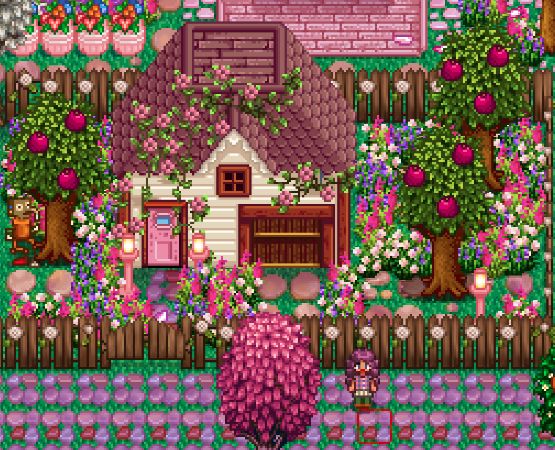Examining various walkthroughs of modified Stardew Valley creator content, I found class discussion of ‘addition MODs’ vs. ‘critique MODs’ to be helpful in analyzing the narrative or aesthetic function of the highlighted modified content. While some content reviewed MODs critiquing original gameplay (i.e. sit and rest MOD allowing players to rebuild stamina by sitting), the majority of creator content I watched on youtube showed how individuals used addition MODs to customize the aesthetic of their game (i.e. foliage mods, animal mods, anime mods). I found the overwhelming proportion of ‘addition MODs’ to give interesting insight into player objectives as it suggests players’ preference for greater customization over functional changes. The majority of creators running ‘addition MODs’ download ‘critique MODs’ as companions, but the full analysis of the videos suggest that customization of game’s aesthetic is of primary importance.
MODs allowing for customization do not only serve solely an aesthetic function, rather they allow players to shape the virtual world in ways that best suit them. As I will explain in further detail below, the players’ ability to shape their virtual world can generate exciting sociological possibilities. In examining the player’s preferences and modifications to the virtual world, value judgments can be determined which correspond to various ideas and identities in the real world. While my methodology is not scientifically based, I offer the following example to showcase how players’ use of MODs can have real world implications.
One trend I found in scouring Youtube walkthroughs was that creators concerned with the aesthetic quality of the game usually downloaded MODs embodying the Japanese aesthetic ‘kawaii’ which celebrates the quality of childlike cuteness. Examples of MODs that attempt to reimagine a ‘kawaii’ Stardew Valley allow players to turn buildings into enchanted gardens and slimes into cute creatures. Creators attempting to achieve a ‘kawaii’ aesthetic were disproportionately women, potentially indicating how a players’ gender impacts elements of their idealized gameplay. One explanation for the abundance of kawaii MODs is that woman-identifying players wanted their femininity to be reflected in the virtual world they cultivated and felt that kawaii’s girly qualities could reshape the original world as imagined by creator Eric Barone to include their identity. Kawaii as an aesthetic necessitates gender-performativity and historically has been interpreted as a measure of femininity; ardent embrace of kawaii corresponds to a grand performance of femininity. While players can perform their femininity in the game through MODs adding luscious gardens and cute baby animals, their performance in game affirms their performance in reality. The performance of femininity is continued into the Youtube walkthroughs, for example: one player who published a video entitled “Cute Pink and Kawaii Stardew Valley Mods” shares a link to a MOD for ‘overgrown fairy buildings’ and exclaims, “I love how pink it is! Iit is just so freaking pretty, it has a lot of different little building options. There we go- there’s some more pink for you.” The player’s excitement of incorporating pink buildings suggests that these kawaii MODs are integral to her experience of gender in the game, as extending her real life gender performativity into the virtual world simultaneously creates a new virtual identity and affirms her corporeal identity.
